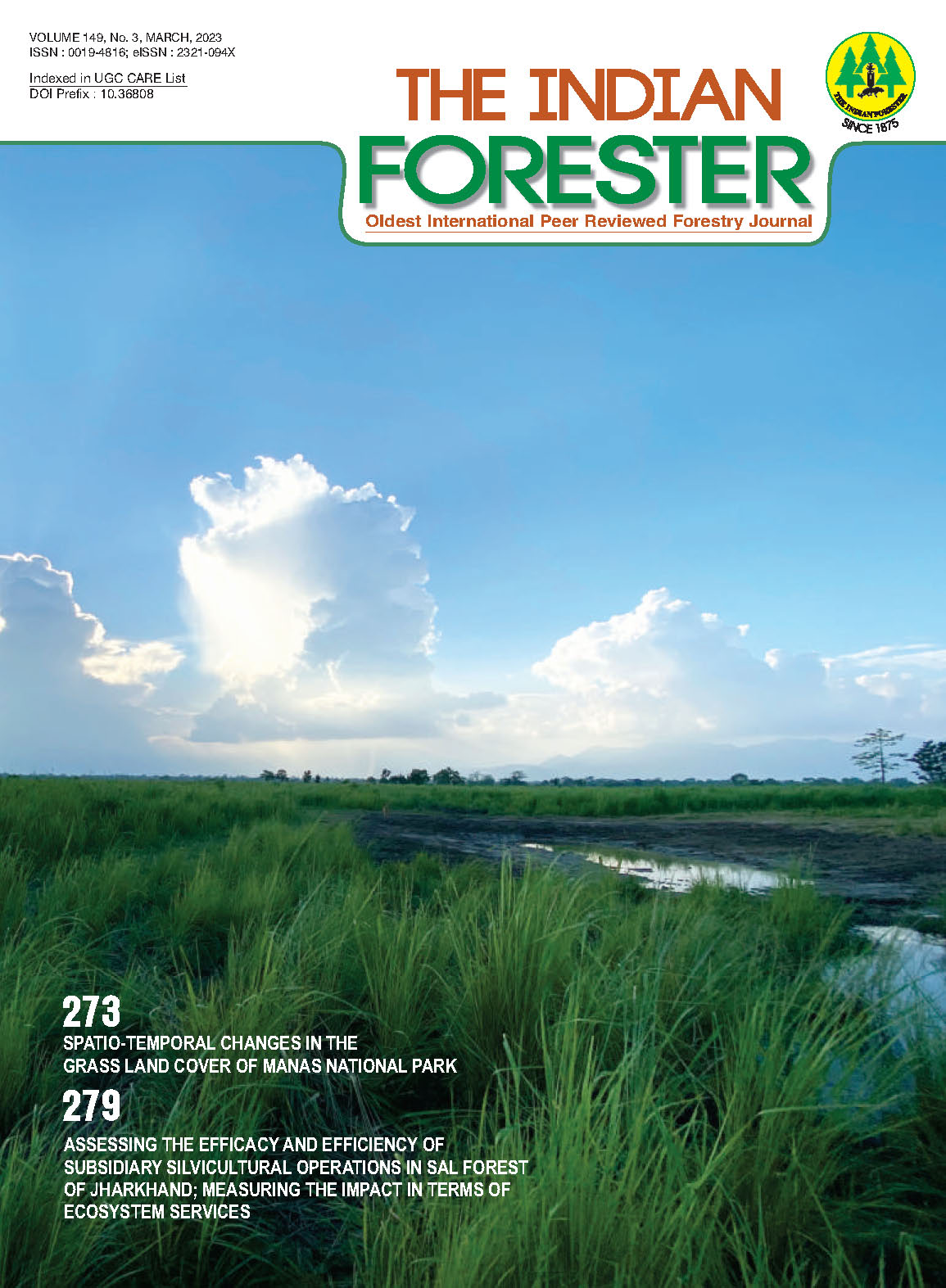Assessing the Efficacy and Efficiency of Subsidiary Silvicultural Operations in Sal Forest of Jharkhand; Measuring the Impact in terms of Ecosystem Services
DOI:
https://doi.org/10.36808/if/2023/v149i3/159813Keywords:
Wood volume, Biomass, Carbon content, Regeneration, Biological diversity, Soil conservation,Abstract
This study is aimed at evaluation of ecological and economical value of Subsidiary Silvicultural Operations (SSOs) in Sal forest of Jharkhand, by measuring its effects in terms of Ecosystem Services (ES) . Data like plant height and girth etc. were collected, from 18 samples and 18 control plots , spread over 3 Agroclimatic Zone, for three models of SSOs . Using the collected data, parameters like wood volume, Biomass, Shannon Wiener Index (H’) , Regeneration status and Soil conserved / ha. were generated .Comparative analysis between sample and control plot shows, SSOs where practised has led to alter significantly, the productivity and biodiversity of forest . In sample plot wood volume growth assessed was 107 m3 /ha. ; Biomass growth 54 m3 /ha , Carbon content 27m3 /ha. Regeneration percentage as calculated 44.45%. Shannon Wiener Index (H’) was found 1.39 and the average of the same for control plots was found to be ; wood volume 61.53 m3 /ha. ; Biomass 20.11 m3 /ha. , carbon content 10.05 m3 /ha. ; Regeneration percentage 28.51% and Shannon Wiener Index (H’) 1.09/ha. Thus in general, SSOs have a positive effect on all the parameters of ecosystem services. Soil conservation effect is found highest in “Northern dry mixed forest†i.e. 21.1 m3 /ha. Subsequently 16.57 m3 /ha in mixed moist and dry deciduous forest and lowest 13.55 m3 /ha. in dry peninsular Sal forest. All the factors like wood volume, biomass, and carbon content, Shannon Wiener Index, regeneration status, soil conservation are important measures for sustainability of any given ecosystem. Therefore SSOs need to be 1promoted to ensure, conserve and increase forest productivity ultimately, achieving sustainable Forest Management, like soil conservation, natural regeneration and biological diversity etc. Study also evaluated the various ES of Forest in terms of monetary value and has found that per hectare enhancement of Rs. 225838 happened in ES NDMF, RS. 324746 in MMDDF and RS. 385120 in DPSF measured by difference between sample and control plot. This gives very significant hope when the same is analysed at ̒ ̒ Forest type level. for this efficacious intervention i.e. SSOs The result showed that in Model no.3 of SSO is the best and dry peninsular Sal forest of Jharkhand as compared with Model no.1, 2 and forest sub type similarly for NDMF, MMDDF.References
Anon. (2021). India State of Forest Report, Forest Cover 2017, Forest Survey of India (accessed on 13 Feb.2022).
Anon. (2017). Annexure II, Carbon stock in India's forest, published by Forest Survey of India. Dehradun, India
Askins R.A. (2001) Sustaining biological diversity in early successional communities: the challenge of managing unpopular habitats. Wildlife Society Bulletin, 20: 407-412.
Blaser J., Sarre A., Poore D. and S.L. Johnson (2011). Status of tropical management 2011. IITO Technical Series, Yokohama, Japan.No.382011.460.
Brawn J.D, Robinson S.K. and Thompson F.R. (2001). The role of disturbance in the ecology and conservation of birds. Ann., 32: 251-276.
Champion F.W. (1951). Subsidiary Silviculture Operations in TANGANYIKA. The East African Agriculture Journal. Forest Department, July1951.
Espelta J.M., Riba M. and Retana J. (1995). Patterns of seedling recruitment in West-Mediterranean Quercus ilex forests influenced by canopy development. J. Veg. Sci., 6: 465–472
Franklin J.F. and Forman R.T.T. (1987). Creating landscape patterns by forest cutting: Ecological consequences and principles. Landscape. Ecol., 1: 5–18. https://doi.org/10.1007/BF02275261
Gourlet-Fleury S., Mortier F., Fayolle A., Baya F., Ouédraogo D., Bénédet F. and Picard N. (2013). Tropical forest recovery from logging: a 24 year silvicultural experiment from Central Africa. Philosophical transactions of the Royal Society of London. Series B, Biological Sciences, 368(1625), 20120302. https://doi.org/10.1098/rstb.2012.0302
Hegde R. and Enters T. (2000). Forest products and household economy: A case study from Mudumalai Wildlife Sanctuary, Southern India, Environment Conservation, 27: 250 – 259.
Johnson R.L. and Krinard R.M. (1983). Regeneration in small and large sawtimber Sweetgum-red oak stands following selection and seed tree harvest. South J. Appl. For., 7: 176–184.
Kneifl M., Kadavy Ì J., Knott R., Adamec Z. and Drápela K. (2015). An Inventory of Tree and Stand Growth Empirical Modelling Approaches with potential application in coppice forestry (a Review). Acta Univ. Agric. Silviculturae Mendelianae Brunensis, 63(5): 1789–1801.
Monzon J., Moyer-Horner L. and Palamar M.B. (2011). Climate change and Species Range Dynamics in Protected Areas. BioScience, 61(10): 752–761. https://doi.org/10.1525/bio.2011.61.10.5.
Petrokofsky G., Sist P., Blanc L. et al. (2015). Comparative effectiveness of silvicultural interventions for increasing timber production and sustaining conservation values in natural tropical production forests. A systematic review protocol. Environ Evid., 4: 8. https://doi.org/10.1186/s13750-015-0034-7
Picchio R., Neri F., Maesano M., Savelli S., Sirna A., Blasi S., Baldini S. and Marchi E. (2011). Growth effects of thinning damage in a Corsican pine (Pinus laricio Poiret) stand in central Italy. For Ecol Manage., 262(2): 237-243.
Putz F.E., Zuidema P.A., Synnott T., Pena-Claros M., Pinard M.A., Sheil D., Vanclay J. K., Sist P., Gourlet-Fleury S., Griscom B., Palmer J. and Zagt R. (2012). Sustaining conservation values in selectively logged tropical forests: the attained and the attainable. Conservation Letters, 5(4): 296-303. https://doi.org/10.1111/j.1755-263X.2012.00242.x
Singh S.P., Rawat Y.S. and Garkoti S.C. (1997). Failure of brown oak (Quercus semicarpifolia) to regenerate in the Central Himalaya: a case of environmental semi-surprise. Current Science, 73: 371-374.
Tilahun A., Soromessa T. and Kelbessa E. (2015). Structure and Regeneration Status of Menagesha Amba Mariam Forest in Central Highlands of Shewa, Ethiopia, Agriculture, Forestry and Fisheries. 4(4): 184-194. doi: 10.11648/j.aff.20150404.16
Venanzi R., Picchio R. and Piovesan G. (2016). Silvicultural and logging impact on soil characteristics in Chestnut (Castanea sativa Mill) Mediterranean coppice.Ecol.Eng.,96:82–89.
Downloads
Downloads
Published
How to Cite
Issue
Section
License
Unless otherwise stated, copyright or similar rights in all materials presented on the site, including graphical images, are owned by Indian Forester.





